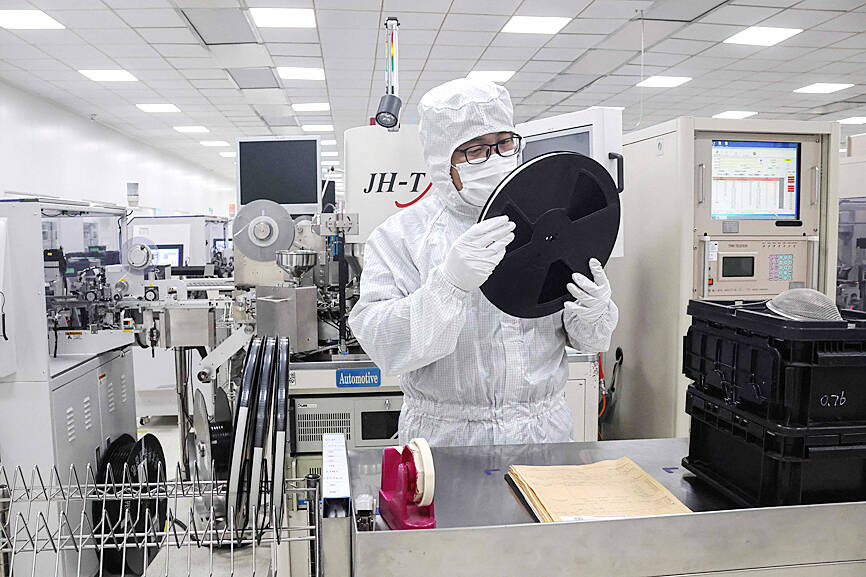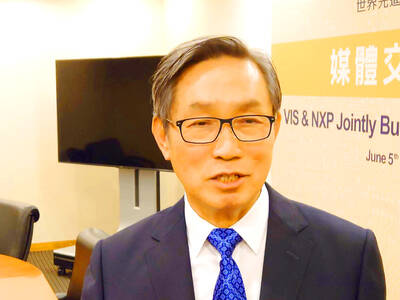The battle for artificial intelligence supremacy hinges on microchips, but the semiconductor sector that produces them has a dirty secret: It is a major source of chemicals linked to cancer and other health problems.
Global chip sales surged more than 19 percent to about US$628 billion last year, according to the Semiconductor Industry Association, which forecasts double-digit growth again this year. That is adding urgency to reducing the effects of “forever chemicals” — which are also used to make firefighting foam, nonstick pans, raincoats and other everyday items — as are regulators in the US and Europe who are beginning to enforce pollution limits for municipal water supplies.
In response to the growing demand, a wave of start-ups are offering potential solutions that would not cut the chemicals out of the supply chain, but destroy them.

Photo: AFP
Per and polyfluoroalkyl substances (PFAS) have been detected in every corner of the planet from rainwater in the Himalayas to whales off the Faroe Islands and in the blood of almost every human tested. Known as forever chemicals because the properties that make them so useful also make them persistent in the environment, scientists have increasingly linked PFAS to health issues including obesity, infertility and cancer.
“There is an urgent need to prevent any further industrial PFAS pollution and clean up existing contamination,” said Lee Bell, technical and policy adviser for the International Pollutants Elimination Network, a global nonprofit network.
Incineration would not destroy the chemicals, “so we need to identify new technologies to meet this challenge,” he said.
Among the companies tackling PFAS is Switzerland-based Oxyle AG. The company’s modular system can be scaled to treat everything from groundwater to industrial wastewater. It works by generating bubbles less than 1mm in diameter — smaller than a grain of salt — in water contaminated with PFAS. The bubbles help grab PFAS molecules and are processed in a way that helps break down the chemicals into its harmless mineral constituents such as carbon dioxide and fluorides.
The process leaves no toxic byproducts, the company said.
The technology can remove more PFAS than conventional filtration approaches. Oxyle said it can reduce some PFAS concentrations from more than 8,700 parts per trillion (ppt) to less than 14ppt, representing a more than 99 percent elimination rate.
That lower concentration is near the detection limit for the six compounds Oxyle tested for, and the start-up emphasized it can further reduce PFAS levels by extending treatment or adjusting the amount of catalyst used.
Although the US and EU are beginning to limit the amount of PFAS allowed in drinking water, there are still few restrictions on what companies can release, said Lenny Siegel, executive director of the California-based Center for Public Environmental Oversight.
Siegel, who has focused on tech sector pollution for decades, said he is unaware of any US fab plant that faces restrictions on PFAS they can release in their wastewater.
Testing data from one US semiconductor plant showed as much as 623ppt of PFAS in wastewater, according to a 2021 study.
New US Environmental Protection Agency (EPA) drinking water guidelines for two types of forever chemical limit concentrations to 4ppt — the lowest “feasible” level, the agency said last year.
It emphasized there is no level of exposure without risk of health effects. (Those rules have been challenged in court, and the cases are on pause at the request of US President Donald Trump’s EPA.)
Conventional water treatment at municipal plants typically involves adding chemicals like aluminum or ferrous sulfates to help bind together dirt and other small particles. Because solids are heavier than water they settle at the bottom and can be separated. The water typically goes through additional filtration systems before it reaches the end user, but this approach was not designed to capture PFAS.
“If you want to make an actual impact which is scalable and affordable, you need to decentralize the treatment. You need to go close to the source of the problem,” Oxyle chief executive officer and cofounder Fajer Mushtaq said. “Treating drinking water is way too late, too expensive and too slow.”
The chips industry can “lead the charge in solving the issue because they have the opportunity to work on their waters in a very controlled environment,” said Steven Lam, head of technology at Gradiant Corp.
The Boston area-based company launched a treatment technology last year that it said permanently removes and destroys PFAS and has several ongoing demonstration projects, including with semiconductor manufacturers.
The biggest barrier to widespread adoption of new PFAS destruction technology is regulatory uncertainty. PFAS limits for drinking water and wastewater in many jurisdictions are evolving with varying standards.
It is crucial that regulators understand the public health benefits of technologies that completely destroy the chemicals over ones that cannot, Gradiant said in a statement.
Although some industries such as apparel are phasing out PFAS and swapping in less-dangerous alternatives, for the chips industry, the chemicals remain crucial.
SEMI, an industry association for the semiconductor supply chain, said that while transitioning from PFAS is necessary, “a lack of proven substitutes means advanced semiconductors cannot be manufactured without them.”
The group added that the sector has “actively established partnerships with governments and academia” to research and develop solutions.
The chips sector is an important market for Oxyle, and the company is in early-stage discussions with several firms, Mushtaq said.
However, it does not have active projects in the industry and is focused on groundwater cleanup and industrial applications in Europe.
“What we need today is not to say we want to ban PFAS in the semiconductor industry. It’s a pipe dream, it’s not going to happen,” she said. “What we need is better waste management.”

TARIFFS: The global ‘panic atmosphere remains strong,’ and foreign investors have continued to sell their holdings since the start of the year, the Ministry of Finance said The government yesterday authorized the activation of its NT$500 billion (US$15.15 billion) National Stabilization Fund (NSF) to prop up the local stock market after two days of sharp falls in reaction to US President Donald Trump’s new import tariffs. The Ministry of Finance said in a statement after the market close that the steering committee of the fund had been given the go-ahead to intervene in the market to bolster Taiwanese shares in a time of crisis. The fund has been authorized to use its assets “to carry out market stabilization tasks as appropriate to maintain the stability of Taiwan’s

STEEP DECLINE: Yesterday’s drop was the third-steepest in its history, the steepest being Monday’s drop in the wake of the tariff announcement on Wednesday last week Taiwanese stocks continued their heavy sell-off yesterday, as concerns over US tariffs and unwinding of leveraged bets weighed on the market. The benchmark TAIEX plunged 1,068.19 points, or 5.79 percent, to 17,391.76, notching the biggest drop among Asian peers as it hit a 15-month low. The decline came even after the government on late Tuesday authorized the NT$500 billion (US$15.2 billion) National Stabilization Fund (國安基金) to step in to buoy the market amid investors’ worries over tariffs imposed by US President Donald Trump. Yesterday’s decline was the third-steepest in its history, trailing only the declines of 2,065.87 points on Monday and

TARIFF CONCERNS: The chipmaker cited global uncertainty from US tariffs and a weakening economic outlook, but said its Singapore expansion remains on track Vanguard International Semiconductor Corp (世界先進), a foundry service provider specializing in producing power management and display driver chips, yesterday withdrew its full-year revenue projection of moderate growth for this year, as escalating US tariff tensions raised uncertainty and concern about a potential economic recession. The Hsinchu-based chipmaker in February said revenues this year would grow mildly from last year based on improving supply chain inventory levels and market demand. At the time, it also anticipated gradual quarter revenue growth. However, the US’ sweeping tariff policy has upended the industry’s supply chains and weakened economic prospects for the world economy, it said. “Now

Six years ago, LVMH’s billionaire CEO Bernard Arnault and US President Donald Trump cut the blue ribbon on a factory in rural Texas that would make designer handbags for Louis Vuitton, one of the world’s best-known luxury brands. However, since the high-profile opening, the factory has faced a host of problems limiting production, 11 former Louis Vuitton employees said. The site has consistently ranked among the worst-performing for Louis Vuitton globally, “significantly” underperforming other facilities, said three former Louis Vuitton workers and a senior industry source, who cited internal rankings shared with staff. The plant’s problems — which have not